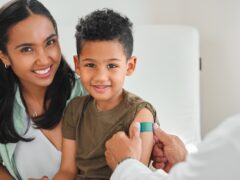What are warts?
Warts are small growths on the skin that normally don’t cause pain. Some warts itch and may hurt, especially if they’re on your feet. There are five kinds of warts:
- Common warts usually appear on the hands.
- Flat warts usually appear on the face and forehead.
- Genital warts (condyloma) appear on the genitals, in the pubic area and between the thighs.
- Plantar warts are found on the bottoms of the feet.
- Subungual and periungual warts are found under or around the fingernails and toenails.
Symptoms of warts
The primary symptom of warts is a rough-surfaced fleshy growth on your skin.
What causes warts?
Warts are a type of infection caused by viruses in the human papillomavirus (HPV) family. There are more than 100 types of HPV. Warts can grow on all parts of your body. They can grow on your skin, on the inside of your mouth, on your genitals, and on your rectal area. Common types of HPV tend to cause warts on the skin (such as the hands and fingers). Other HPV types tend to cause warts on the genitals and rectal area. Some people are more naturally resistant to the HPV viruses and don’t seem to get warts as easily as other people.
How are warts diagnosed?
Most of the time, your doctor will be able to identify a wart just by looking at it. In some cases, they may also scrape the wart to look for tiny dots. These are the tell-tale signs of clotted blood vessels and are common in some warts.
In some cases, your doctor may be uncertain if your skin growth is a wart. If so, they may remove part of the wart to send to a laboratory for identification.
Can warts be prevented or avoided?
Some warts can be prevented, others cannot. Warts may be naturally occurring, depending on what’s causing them. But warts also may be passed from person to person by touch. It is also possible to get warts from using towels or other objects that were used by a person who has warts.
Warts on the genitals are very contagious and can be passed to another person during oral, vaginal, or anal sex. It is important not to have unprotected sex if you or your partner have warts on the genital area. Warts also can grow on the cervix (inside the vagina) without a person knowing it. They may then pass the infection to their sexual partner.
Wart removal
Warts often disappear on their own, although it may take months or years to do so. But some warts won’t go away on their own and need to be treated. Treatment may decrease the chance that the warts will be spread to other areas of your body or to other people.
Warts on the skin
There are many ways to remove common warts from the skin (such as on the fingers, feet, and knees). Talk to your doctor about which treatment is right for you. Also talk with your doctor before treating warts on your face.
- Applying salicylic acid. You can treat warts on places such as the hands, feet, or knees by putting salicylic acid (one brand name: Compound W) on the warts. After you take a bath or shower, pat your skin dry with a towel. Then apply the salicylic acid. The acid sinks in deeper and works better when it is applied to damp skin. Before you take a shower or a bath the next day, use an emery board or pumice stone to file away the dead surface of the warts. Apply the acid every day for many weeks as directed.
- Applying cantharidin. Your doctor may “paint” the chemical cantharidin on your warts. Most people don’t feel any pain when the chemical is applied. However, you may experience some pain and blistering of the wart about 3 to 8 hours later. Follow your doctor’s instructions for at-home care. When you return to your doctor for your follow-up visit, they will remove the dead skin of the wart. If the wart isn’t gone after one treatment, your doctor may suggest another treatment.
- Applying liquid nitrogen. Your doctor may use liquid nitrogen to freeze the wart. This treatment is called cryotherapy or cryosurgery. This is a two-step process that does not hurt the skin around the wart. Applying liquid nitrogen to the wart causes a little discomfort. To completely remove a wart, the treatments may be needed every 1 to 3 weeks for a total of 2 to 4 times. If no improvement is noted, your doctor may recommend another type of treatment.
- Other treatments for warts on the skin. Your doctor may choose to burn the wart, cut it out, or remove it with a laser. These treatments are effective, but they may leave a scar. They are normally reserved for warts that have not cleared up with other treatments.
Warts on the genital area
Genital warts must be treated by your doctor. Warts in the genital area can be removed, but there’s no cure for the viral infection that causes the warts. This means that the warts may come back even after they have been removed.
Note that warts on the skin and warts on the genitals are removed in different ways. Don’t try any home remedies or over-the-counter drugs to remove warts on the genital area. You could hurt your genital area by putting certain chemicals on it.
Living with warts
Most of the time, wart removal treatment on the skin is successful and the warts are gone for good. Genital warts are more likely to come back. If warts come back, see your doctor to talk about other ways to treat them.




